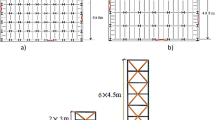Abstract
This chapter seeks to determine the optimal structural design parameter values for a 6-story controlled rocking steel braced frame (CRSBF) building that minimizes the upfront (initial construction) and earthquake-induced economic and environmental impacts. The dead load on the rocking frame, initial post-tensioning force, fuse strength and frame aspect ratio are the considered parameters. Earthquake-induced economic losses are assessed using the FEMA P58 methodology and the Economic Input-Output Life Cycle Assessment is used to quantify greenhouse gas emissions associated with initial construction and repair and replacement activities following earthquake damage. Surrogate models are developed as compact representations of the statistical relationship between the structural design parameters and economic and environmental impacts. Once validated, the surrogate models are used to perform single- and multi-objective optimization using the desirability function approach. Differences in the sensitivity of the two impact categories (environmental and economic) to variations in the individual structural design parameters are also highlighted.
Access this chapter
Tax calculation will be finalised at checkout
Purchases are for personal use only
Similar content being viewed by others
References
ASCE. (2016). Minimum design loads for buildings and other structures. ASCE 7-16, Reston, VA.
Baker, J. W. (2015). Efficient analytical fragility function fitting using dynamic structural analysis. Earthquake Spectra, 31, 579–599.
Derringer, G., & Suich, R. (1980). Simultaneous optimization of several response variables. Journal of Quality Technology, 12(4), 214–219.
Dyanati, M., Huang, Q., & Roke, D. (2017). Cost-benefit evaluation of self-centering concentrically braced frames considering uncertainties. Structure and Infrastructure Engineering, 13(5), 537–553.
Eads, L., Miranda, E., & Lignos, D. G. (2015). Average spectral acceleration as an intensity measure for collapse risk assessment. Earthquake Engineering and Structural Dynamics, 44(12), 2057–2073.
Eatherton, M., & Hajjar, J. (2010). Large-scale cyclic and hybrid simulation testing and development of a controlled-rocking steel building system with replaceable fuses. NSEL-025, Department of Civil and Environmental Engineering, University of Illinois at Urbana-Champaign.
Eatherton, M. R., & Hajjar, J. F. (2011). Residual drifts of self-centering systems including effects of ambient building resistance. Earthquake Spectra, 27(3), 719–744.
Eatherton, M. R., Ma, X., Krawinkler, H., Mar, D., Billington, S., Hajjar, J. F., & Deierlein, G. G. (2014). Design concepts for controlled rocking of self-centering steel braced frames. Journal of Structural Engineering. https://doi.org/10.1061/(asce)ST.1943-541X.0001047.
FEMA (Federal Emergency Management Agency). (2009). Quantification of building seismic performance factors (FEMA P695). Redwood City, CA.
FEMA (Federal Emergency Management Agency). (2012). Seismic performance assessment of buildings (FEMA P-58, Vols. 1 and 2). Redwood City, CA.
Hall, K. S., Eatherton, M. R., & Hajjar, J. F. (2010). Nonlinear behavior of controlled rocking steel-framed building systems with replaceable energy dissipating fuses. Newmark Structural Engineering Laboratory, University of Illinois at Urbana-Champaign.
Hendrickson, C., Horvath, A., Joshi, S., & Lave, L. (1998). Economic input-output models for environmental life-cycle assessment. Environmental Science and Technology, 32(7), 184A–191A.
Lee, J. Y., & Ellingwood, B. R. (2015). Ethical discounting for civil infrastructure decisions extending over multiple generations. Structural Safety, 57, 43–52.
Ma, X., Krawinkler, H., & Deierlein, G. G. (2011). Seismic design and behavior of self-centering braced frame with controlled rocking and energy dissipating fuses. John Blume Earthquake Engineering Center, TR 174, Stanford, CA.
Mckenna, F. T. (1999). Object-oriented finite element programming: Frameworks for analysis, algorithms and parallel computing (Ph.D. dissertation, University of California, Berkeley).
Montgomery, D. C. (2013). Design and analysis of experiments. Hoboken: Wiley.
Myers, R. H., Montgomery, D. C., & Anderson-Cook, C. M. (2009). Response surface methodology: Process and product optimization using designed experiments (3rd ed.). New York: Wiley.
Ochoa, L., Hendrickson, C., & Matthews, H. (2002). Economic input-output life-cycle assessment of US residential buildings. Journal of Infrastructure Systems, 8(4), 132–138.
Sharrard, A. L., Matthews, H. S., & Ries, R. J. (2008). Estimating construction project environmental effects using an input-output-based hybrid life-cycle assessment model. Journal of Infrastructure Systems, 14(4), 327–336.
Shokrabadi, M., & Burton, H. V. (2017). Ground motion intensity measures for rocking building systems. Earthquake Spectra, 33(4), 1533–1554.
Steele, T. C., & Wiebe, L. D. A. (2016). Dynamic and equivalent static procedures for capacity design of controlled rocking steel braced frames. Earthquake Engineering and Structural Dynamics, 45(14), 2349–2369.
Steele, T. C., & Wiebe, L. D. A. (2017). Collapse risk of controlled rocking steel braced frames with different post-tensioning and energy dissipation designs. Earthquake Engineering and Structural Dynamics, 46(13), 2063–2082.
Sun, H., Burton, H. V., Zhang, Y., & Wallace, J. W. (2017). Interbuilding interpolation of peak seismic response demands using spatially correlated demand parameters. Earthquake Engineering Structural Dynamics, 47(5), 1168–1188.
Uriz, P., Filippou, F. C., & Mahin, S. A. (2008). Model for cyclic inelastic buckling of steel braces. Journal of Structural Engineering, American Society of Civil Engineers, 134(4), 619–628.
Weber, C., Matthews, D., Venkatesh, A., Costello, C., & Matthews, H. (2009). The 2002 US benchmark version of the economic input-output life cycle assessment (EIO-LCA) model. Green Design Institute, Carnegie Mellon University.
Wiebe, L., & Christopoulos, C. (2015). Performance-based seismic design of controlled rocking steel braced frames. I: Methodological framework and design of base rocking joint. Journal of Structural Engineering, 141(9), 04014226.
Wiebe, L., Christopoulos, C., Tremblay, R., & Leclerc, M. (2013). Mechanisms to limit higher mode effects in a controlled rocking steel frame: Large amplitude shake table testing. Earthquake Engineering and Structural Dynamics, 42(7), 1069–1086.
Acknowledgements
This research is supported by National Science Foundation Award No. 1554714.
Author information
Authors and Affiliations
Corresponding author
Editor information
Editors and Affiliations
Rights and permissions
Copyright information
© 2019 Springer Nature Singapore Pte Ltd.
About this chapter
Cite this chapter
Burton, H.V., Lee, J.Y., Moradi, S., Dastmalchi, S. (2019). Multi-objective Performance-Based Design Optimization of a Controlled Rocking Steel Braced Frame System. In: Noroozinejad Farsangi, E., Takewaki, I., Yang, T., Astaneh-Asl, A., Gardoni, P. (eds) Resilient Structures and Infrastructure. Springer, Singapore. https://doi.org/10.1007/978-981-13-7446-3_10
Download citation
DOI: https://doi.org/10.1007/978-981-13-7446-3_10
Published:
Publisher Name: Springer, Singapore
Print ISBN: 978-981-13-7445-6
Online ISBN: 978-981-13-7446-3
eBook Packages: EngineeringEngineering (R0)




